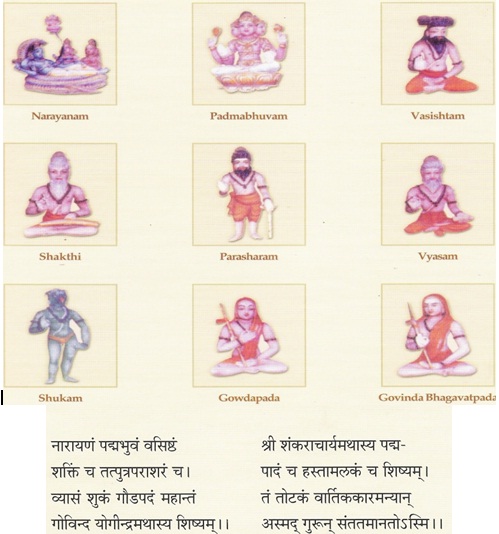Preceptors of Advaita 7 GOVINDA BHAGAVATPADA 1 To be known to all posterity as the preceptor of a world teacher – Jagadguru Sri Sankaracharya – is indeed a rare honour. It evokes our sense of wonder. When we remember that Isvara Himself was born as Sri Sankara for the spiritual rejuvenation of Hinduism, our wonder knows no bounds. But it may be asked whether a world teacher – especially if He is none other than the Supreme Lord Himself – needs a teacher. The answer is that the world will learn more readily by example rather than precept. The need for a teacher, especially in spiritual matters, is generally recognised. It is he who dispels the darkness of ignorance and frees us from all sorrow. He quickens our understanding and makes us see either what we had not seen before or what we had seen all too dimly. He makes the effulgence of wisdom which is latent in us shine forth in all its splendour. To make us realise this need for guru, He who is the preceptor of all preceptors set an example by Himself sitting at the feet of a guru. He wants us to realise that one who has not learned to obey is not fit to command and that one who has not himself sat at the feet of a worthy teacher, cannot become a teacher himself. The preceptor who enjoys this honour of being the preceptor of Sri Sankara is Sri Govinda Bhagavatpada. In his purvasrama, he was Chandra Sarma, a handsome Brahmin of Kashmir. Yearning to hear Patanjali’s exposition of the vyakarana at Chidambaram, he was coming to the South. On the bank of the River Narmada, he saw Gaudapada who under a curse from Patanjali for leaving the place of instruction without permission had become a Brahmaraksas. Patanjali had decreed that the curse would be lifted when Gaudapada found a disciple fit enough to learn the vyakarana. It so happened that till the arrival of Chandra Sarma, every scholar who came that way went wrong in giving the ending of a tricky word and was eaten up by the Brahmaraksas. Chandra Sarma proved an exception. He gave the correct ending. The time for the lifting of the curse had come. Gaudapada asked Chandra Sarma where he was going. On being told that he was going to Chidambaram to learn at the feet of Patanjali, Gaudapada said that the exposition at Chidambaram was over and that he would himself teach the young man. But the condition was that without getting down from the tree on which the Brahmaraksas sat, and without sleeping, the disciple should learn what he was taught as quickly as possible. Having no access to writing materials, Chandra Sarma made a deep scratch in his thigh and with the blood that oozed out wrote on the leaves of the tree all that he was taught. The instruction continued night and day without food and sleep for nine days. On the completion of his instruction, he gathered up the leaves and tying them up into a bundle, took leave of his teacher. According to the Patanjali-vijaya, a work by Ramabhadra Dikshita written about 200 years ago, Chandra Sarma is none other than Patanjali himself. Feeling that Gaudapada was not likely to secure a suitable disciple and thus might have to languish under his curse, Patanjali took pity on him and was himself born as Chandra Sarma. This was but one more of the many roles that Patanjali played. Patanjali is none other than Adisesha. Among the roles he played, those of Lakshmana and Balarama may be remembered. govindadesikamupasya chiraya bhaktya The writer wishes to place on record his deep sense of gratitude to His Holiness the present Sankaracharya of Kanchi for the material of this biography. (Vide His Holiness’ Madras lectures, 1932). Preceptors of Advaita - Other Parts:
|
